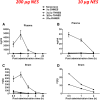Nestorone® as a Novel Progestin for Nonoral Contraception: Structure-Activity Relationships and Brain Metabolism Studies
- PMID: 27824503
- PMCID: PMC5412978
- DOI: 10.1210/en.2016-1426
Nestorone® as a Novel Progestin for Nonoral Contraception: Structure-Activity Relationships and Brain Metabolism Studies
Abstract
Nestorone® (NES) is a potent nonandrogenic progestin being developed for contraception. NES is a synthetic progestin that may possess neuroprotective and myelin regenerative potential as added health benefits. In receptor transactivation experiments, NES displayed greater potency than progesterone to transactivate the human progesterone receptor (PR). This was confirmed by docking experiments where NES adopts the same docking position within the PR ligand-binding domain (LBD) as progesterone and forms additional stabilizing contacts between 17α-acetoxy and 16-methylene groups and PR LBD, supporting its higher potency than progesterone. The analog 13-ethyl NES also establishes similar contacts as NES with Met909, leading to comparable potency as NES. In contrast, NES is not stabilized within the human androgen receptor LBD, leading to negligible androgen receptor transactivation. Because progesterone acts in the brain by both PR binding and indirectly via binding of the metabolite allopregnanolone to γ-aminobutyric acid type A receptor (GABAAR), we investigated if NES is metabolized to 3α, 5α-tetrahydronestorone (3α, 5α-THNES) in the brain and if this metabolite could interact with GABAAR. In female mice, low concentrations of reduced NES metabolites were identified by gas chromatography/mass spectrometry in both plasma and brain. Electrophysiological studies showed that 3α, 5α-THNES exhibited only limited activity to enhance GABAAR-evoked responses with WSS-1 cells and did not modulate synaptic GABAARs of mouse cortical neurons. Thus, the inability of reduced metabolite of NES (3α, 5α-THNES) to activate GABAAR suggests that the neuroprotective and myelin regenerative effects of NES are mediated via PR binding and not via its interaction with the GABAAR.
Copyright © 2017 by the Endocrine Society.
Figures






References
-
- Sitruk-Ware R. New progestagens for contraceptive use. Hum Reprod Update. 2006;12(2):169–178. - PubMed
-
- Kumar N, Koide SS, Tsong Y, Sundaram K. Nestorone: a progestin with a unique pharmacological profile. Steroids. 2000;65(10-11):629–636. - PubMed
-
- Heikinheimo O, Noe G, Haukkamaa M, Lähteenmäki P. The progestin ST 1435: rapid metabolism in man. Contraception. 1994;50(3):275–289. - PubMed
-
- Heikinheimo O, Ranta S, Moo-Young A, Lähteenmäki P, Gordon K. Parenteral administration of progestin Nestorone to lactating cynomolgus monkeys: an ideal hormonal contraceptive at lactation? Hum Reprod. 1999;14(8):1993–1997. - PubMed
Publication types
MeSH terms
Substances
Grants and funding
LinkOut - more resources
Full Text Sources
Other Literature Sources
Medical
Research Materials

